Despite their small size, fleas can be a huge problem.
If you’ve noticed these tiny black parasites jumping around on your cat there is no doubt you are eager to deal with the issue as quickly and efficiently as possible.
If you’re keen for a quick solution to your cat’s problem here are our best five cat flea treatments:
Keep reading to read our guide to cat flea treatment or you can skip to our cat flea product reviews.
If your pet has had fleas before then you will know how challenging it can be to completely get rid of them.
Prevention through the use of regular flea control is important but if your cat has fleas, immediate treatment of your cat and your home is absolutely necessary.
You may have noticed your cat is uncomfortable and itchy due to the irritation and skin issues caused by the fleas.
If your cat is constantly scratching, excessively grooming and is developing bald spots and scabs it may be due to fleas.

A quick online search reveals a vast range of flea treatment options available, so much so that even choosing a treatment route can seem overwhelming.
We have created this guide so you have all the information you need when dealing with fleas and deciding on the best flea treatment for your cat.
Contents
A Guide to Cat Flea Treatment

Treating your cat and your home as soon as possible is of great importance when it comes to fleas, this is because the longer the problem is left the worse the flea infestation will become and the harder it is to ensure all fleas, pupae, larvae and eggs are removed.
Available cat flea treatments vary from combs to spot-on treatments to sprays, collars, powders and tablets.
Each treatment route has pros and cons and many need to be used in conjunction with another treatment type in order to be fully effective.
Remember, vets can provide advice on flea treatments and will be able to help you put in place measures that prevent a flea infestation from occurring in the future.
How to Tell If Your Cat Has Fleas
As fleas are so small and fast moving it can be difficult to tell if your cat has fleas or if there is another issue that is causing the symptoms you are seeing.
With this in mind, you could have a problem with fleas even if you haven’t actually seen a flea, here are some of the classic signs to look out for in your cat:
- Excessive scratching and biting
- Intense grooming, sometimes leading to bald patches
- Restlessness Scabs and lesions on the skin
- Lethargy
- Anaemia – signs of anaemia include pale gums, extreme tiredness and muscle loss
- Specks in your cat’s fur
If you have seen some of the above signs, try to take a close look at your cat’s fur to see if you can spot the small bugs bouncing around.
Sitting your cat on a white sheet can make it easier to spot any fleas or spiral flea dirt that might dislodge while you are looking.
A flea comb can be used to help you look closely at your cat’s fur and can actually catch fleas and eggs (which look like salt and pepper flakes).
Fleas tend to like hiding at the back of the neck, inside of the legs and at the base of the tail so these are hotspots worth investigating if you have suspicions that fleas are bothering your kitty.
Where Do Fleas Come From?

Fleas seem to appear out of nowhere and once they are around, they waste no time in multiplying.
The fleas begin as eggs which are usually laid in protected areas outside such as shaded parts of gardens, these areas essentially become incubators for fleas and once the eggs hatch, the fleas are picked up by unsuspecting wildlife and pets that are passing through the area.
As animals often use these covered, protected areas to seek shelter (or go to the toilet!) it gives the fleas an opportunity to climb onto them.
Fleas are primarily picked up from the environment, namely from gardens.
This is why pets who spend a lot of time outdoors are more susceptible to fleas, although flea eggs may also be present within the home, for example in carpets, from previous flea infestations.
As flea eggs can remain dormant for up to 5 months, a re-infestation can occur and this can happen even after your pet has been treated and has been clear of fleas for some time.
As it usually takes a couple of weeks to detect a flea infestation this gives the fleas time to lay lots of eggs, most of which are dropped onto carpets, sofas, pet beds etc. and these flea eggs can hatch later meaning your flea problem could be starting a lot closer to home than you first thought.
This is one of the main reasons it is difficult to get the problem under control once your cat has fleas once and why it is so important to not only treat your cat but also treat your home.
How to Get Rid of Your Cat’s Fleas
Now that you have established your cat has fleas, it is important to begin treatment as soon as possible as the fleas that you have actually seen represent just a small percentage of the total number of fleas that are in your home.
There are many techniques used to get rid of fleas and, as expected, some are more effective than others.
The best treatment for fleas are ones that are fast acting, non-toxic and easy to apply.

Getting rid of fleas involves killing them or stopping them from reproducing and removing them from your cat and home.
Our guide covers a range of treatment options to give you all the information you need to successfully deal with a flea problem.
We take a look at some of the most popular methods, all of which are readily available, affordable solutions.
Use A Flea Comb

A flea comb is a very handy, cost-effective way of identifying whether or not your cat has fleas.
As early identification makes it a lot easier to fight the fleas, many people reach for a flea comb first but this is not a preventative measure and when used alone it will not be effective in completely getting rid of the fleas.
Using a flea comb will help to remove a portion of the fleas and eggs which will provide some immediate relief to your cat.
You should use another treatment method alongside combing (for example flea shampoo or spray) to completely rid your cat of fleas.
When you use a flea comb you should have a small pot of hot, soapy water on hand so you can rinse and clean the comb in between strokes.
- Effective: This cat comb helps to prevent further infestation
- Reduces Skin Irritation: Comb for cats identifies dry, flaky skin to reduce skin irritation
- For Short & Long Hair: Safari cat comb is a must-have in your cat grooming supplies
- Keep Your Cat Healthy: This 6.25" long and 1.375" wide comb keeps cats healthy and beautiful
- No More Pests: Removes pests from your cat's coat without irritating skin
You may decide to comb your cat outside to avoid flea eggs from falling onto the floor in your home.
After combing your cat and cleaning the comb thoroughly in the soapy water, dispose of the water down the drain and vacuum the area (or hose the area if outside) to make sure any loose flea eggs are removed.
We have mentioned that combing needs to be used alongside another treatment method in order to be effective in stopping the fleas but used alone once or twice a week it can be a very effective early identification method.
If your cat doesn’t like to be brushed or combed you may end up skipping this method altogether, fortunately there are several other ways you can get rid of fleas without needing to comb your cat.
Bathe Your Cat with Flea Shampoo
Using a flea shampoo is an effective, safe and affordable way to get rid of fleas on your cat.
- TARGETS ITCHING: Our dog flea shampoo gives you a perfect shine and clean coat from head to toe. It has a unique formula that keeps your pets looking and feeling great.
A single wash with a good quality cat shampoo will kill the existing fleas and help to calm your cat’s irritated skin.
Flea baths are a good way to kill fleas but many do not protect your cat against re-infestation, therefore you will need to keep your cat in a flea-free zone after bathing while you clear the rest of the house of fleas otherwise your cat will just pick them up again straight away and you’ll be back to square one.
Some shampoos are designed to kill fleas while others are designed to repel them so the shampoo you choose will depend on whether you are treating or preventing fleas.
Take care when choosing a shampoo and try to go for cat-specific, toxic-free options.

Also, be sure to read the product information and follow the usage guidelines as many flea shampoos are not suitable for use on kittens and can have adverse effects if you use more than the recommended amount.
The best way to bathe your cat is to place them in the sink, wet their coat with lukewarm water then gently lather the shampoo over their neck, body and tail before thoroughly rinsing.
Once all of the shampoo has been rinsed away, use a towel to dry your cat as much as possible and then they are good to go!
Although many cats hate baths it is sometimes necessary and it may be worth it to give them one bath to rid them of fleas and relieve their itching.
If your cat is really against the idea you may be able to find a no-rinse shampoo or you could use a flea spray instead.
Use A Flea Spray
A flea spray is applied directly to your cat’s fur and skin, it will kill fleas on contact and will also kill eggs and larvae, a spray can be effective for anything from a few days up to a few months depending on the product used.
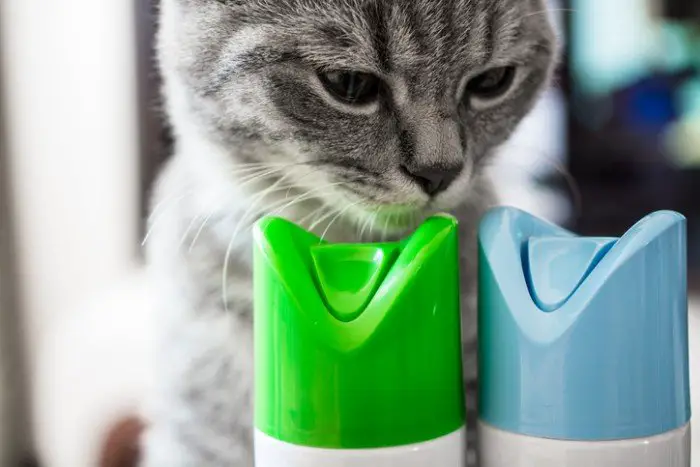
Some flea sprays contain harsh chemicals so it is important to take care in choosing one that is safe and non-toxic.
The amount you can safely spray on your cat usually depends on the cat’s weight so be sure to read the guidelines carefully for dosage and safety information.
Some of the sprays cannot be used on kittens, while others can, so double check your spray before you use it on younger cats.
Sprays are cost-effective but tend to be less common now as stronger spot-on treatments are used more often.
No products found.
An advantage of using a spray is that it is usually effective against multiple parasites and can be used on furniture and pet bedding as well as on pets themselves which helps to deal with the problem on multiple levels rather than only dealing with the fleas that are on your cat at the time of spraying.
It is also handy that when you use a spray you don’t have to wet or wash your cat as many cats hate water and will put up a fight if you try to wash them.
Make Sure You Treat All Your Pets
You may have noticed fleas on one of your pets but not on the rest, although that may seem like a positive sign, it doesn’t mean you should only treat one of your pets.
It may be true that the fleas are worse on just the one pet but that doesn’t mean the others haven’t got any fleas or eggs in their fur.

Your infested pet will be dropping fleas and eggs where they walk and rest so if your other pets walk or spend time in the same areas there is a good chance they will pick up fleas too.
Remember that the fleas you see only account for a very small percentage of the total fleas that are present and this means there’s a very high likelihood that your other pets are affected even if you haven’t seen fleas on them.
By dealing with just one pet, the flea problem will continue so you need to treat all of your pets as well as your home in order to get a handle on the problem.
While treating one pet may temporarily improve the symptoms they are showing, it won’t be long before they pick up more eggs from the carpets or your other pets and the cycle continues.
That is why treating all pets is essential.
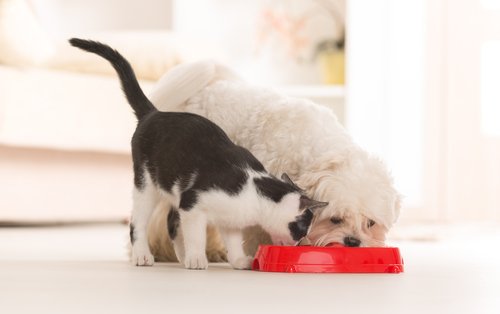
Ideally, you will want to treat all of your pets at the same time and keep them in an area that has been treated while you treat the rest of the home, this way you can be sure that all of your pets are free from flees and they won’t pick up more eggs when they walk around the house again.
Whatever treatment route you decide to take, be thorough and make sure each of your pets receives treatment.
Even if the fleas have not reached all of your pets yet, the treatment can help ensure any eggs are removed and will also act as a preventative measure.
How to Get Rid of Fleas in Your Home
Dealing with fleas can seem like a never-ending chore but this is often because your pet is being re-infected by the eggs that lay dormant in your home, eggs are most commonly in carpets and pet bedding.
Using this step by step guide you can have your home completely flea free in no time at all.
The key is to be thorough and remember that the problem is not just the fleas that you see on your pet.

Treat your pet, treat your home and you will treat the problem.
All of the stuff you can pick up and put into the washing machine, do so in order to help get rid of the fleas. Once the stuff is washed, put it in the dryer to be sure that no fleas remain.
Vacuuming your home is a great way to pick up fleas.
Be sure to move furniture so you can get underneath it and get into all the corners and crevices that tend to attract fleas.
Wherever your pet likes to spend time, hoover that area and stop the fleas from making themselves at home.
It’s a good idea to hoover the areas your pet spends the most time every day while there are fleas around in order to help get the problem under control.

Even the most thorough washing and vacuuming can leave a few fleas or eggs behind so using a spray will help to break the reproduction cycle of any remaining fleas and will play a role in putting a stop to the problem.
Try to use a natural, non-toxic spray – it is quite handy as many of the cat treatment sprays that can be used on your cat also be used on furniture but be sure to double check to avoid staining your furniture.
It is very difficult to pick up every single one of the eggs and larvae in one go so don’t be surprised if you do notice a few fleas.
It is best to repeat the cleaning process after a couple of days to be sure that the problem has been dealt with. If you notice more fleas, go through these steps focusing on that particular area.
Use the spray in the flea hot spots (fleas tend to like warm, sheltered spots).
If you’re not sure whereabouts in the garden the fleas may be, think about where your pet likes to hang out and treat those areas. Another way you can stop the fleas is by hosing down these areas.
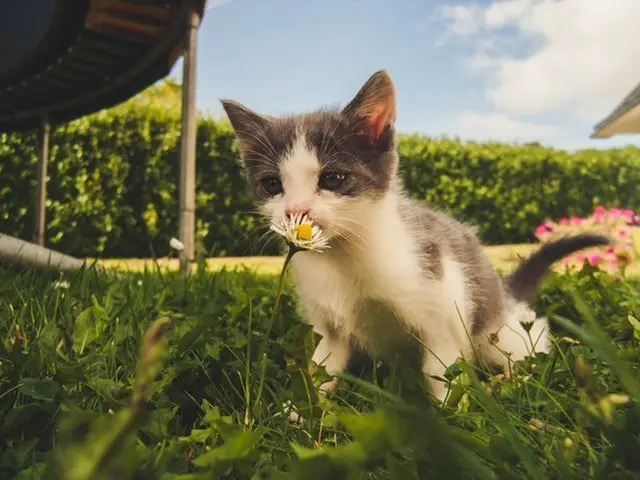
As you can see, fleas are a multi-layered issue and require a fair bit of cleaning and treatment to get rid of.
It may be surprising but dealing with the fleas on your pet is often the easy part, it is getting rid of all the eggs that have been dropped around your home and garden that is the more difficult.
Use this step by step guide to ensure you have removed all of the fleas and flea eggs from your home as this is a vital part of stopping the problem as a whole.
Cat Flea Treatment Reviews
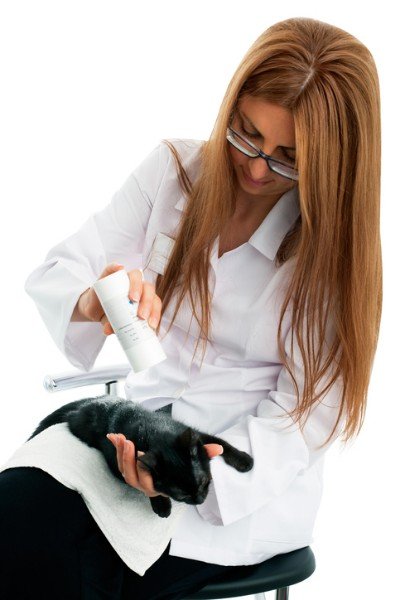
To help you choose a flea treatment for your cat, we have reviewed five of the most popular options. You have likely heard of these products before and you may be wondering how effective they really are.
These five treatments are all affordable and work well against fleas but they each have their pros and cons.
Some of the products are designed for protecting your cat long-term while others have an instant but short-term effect.
To help you decide, we have taken a closer look at these products and have given you all the information you need to find an option that suits your situation and requirements.
1. Frontline Spot On
No products found.
This affordable spot-on treatment by Frontline is designed to be used monthly to help safely remove your cat’s ticks, fleas and lice.
The spot-on kills fleas within 24 hours and kills ticks within 48 hours.
You can buy the treatment in packs of 1 pipette, 3 or 6 with 1 pipette being the equivalent to one treatment that lasts one month.
You can either use this as a preventative measure by applying one pipette to your cat on a monthly basis or you can use it as a treatment when you notice your cat has fleas.
The spot-on can only be used on cats older than eight weeks and weighing more than 1kg and comes with a warning not to be used on rabbits.
It is also good to know that this treatment can be used on cats during pregnancy and when nursing.
The treatment is very easy to apply; you simply hold the pipette upright, break the top of the nozzle off and then apply the product to your cat’s skin, first apply part of the solution at the base of the skull and then apply the rest a few centimetres back between the shoulder blades (make sure you part your cats fur and apply directly to the skin).
The most important thing is making sure your cat cannot lick the product off, if you have more than one cat make sure your other cats don’t lick that area either.
It is also recommended that you do not bathe your cat for 2 days after applying the treatment.
Frontline is a well-known and trusted brand that offers high-quality products, this spot on treatment is available to buy online and in stores but was originally only available through veterinary prescription which indicates the reliability of the product.
It is now far more convenient for owners to buy this product without a prescription and keep their cats flea-free.
Pros
- Easy to administer and affordable
- Deals with multiple species (fleas and ticks)
- Designed specifically for cats
Cons
- Cannot be used on kittens or cats weighing under 1kg
- Some users have reported this spot-on is ineffective with concerns that fleas have become immune to the product
- There have also been complaints regarding inconsistent results
2. FIPROtec Spot On
- Easy to use Spot-on
- Contains Fipronil
- Kills fleas for up to 5 weeks
- For cats over 8 weeks of age
- For cats weighing more than 1kg
FIPROtec Spot On is effective against fleas and ticks, it comes in packs of 6 pipettes.
The treatment works using the active ingredient Fipronil (the same active ingredient as Frontline and at the same strength) which allows the product to be effective for up to 5 weeks after the treatment is applied.
The spot-on works by killing fleas and ticks through contact and it takes up to 24 hours to kill fleas and between 24 – 48 hours to kill ticks.
It is recommended that this spot-on is reapplied every four weeks to provide your cat with continuous protection.
The spot on cannot be used on cats younger than 8 weeks, cats who weigh less than 1kg or on pregnant or nursing females.
If this product is not suitable for use on your cat it is advised to seek a suitable alternative product to protect them against fleas.
Another recommendation is that you do not use this product in conjunction with any other flea control product including collars or tablets.
FIPROtec is manufactured by Beaphar who have been making pet products for more than 75 years.
They aim to assist pet owners in caring for their pets and their spot on treatment is independently assessed and licensed by the Veterinary Medicines Directorate to ensure it is an effective and high-quality product.
This spot on treatment is applied in the same way as the Frontline spot on – in two places at the back of the head and between the shoulder blades.
Beaphar give you advice on overcoming a flea problem to help ensure you are able to get on top of the problem in its entirety.
They also advise you to regularly (every three months) worm your cat as if a cat has fleas there is a possibility they have worms too.
This spot-on treatment is slightly cheaper than other brands and has a good reputation for its effectiveness against fleas, even in multi-pet households.
Pros
- Cheaper than many other brands using the same active ingredient
- Effective against fleas and ticks
- Long lasting – lasts up to five weeks
Cons
- Cannot be used alongside any other flea treatments
- Cannot be used on kittens, pregnant females or nursing females
- Mixed reviews with some users reporting the product to be ineffective
3. Vets Best Natural
Vets Best Natural spot-on treatment offers a plant-based alternative to chemical-based flea treatment products.
Many people do not want to use synthetic or chemical products on their pets so are searching for a plant-based alternative, although this is not the only reason you may be leaning towards a natural solution.
Some cats experience skin reactions to chemical-based treatments so a natural product may be a suitable solution that is gentler on your pet’s skin.
This spot on is designed to repel fleas and, when used regularly, provides lasting pest control.
The product uses no synthetic insecticides and is created using a blend of plant-based ingredients including Margosa Extract which is an active substance that acts as a powerful repellent and provides long-lasting protection against fleas, mites and ticks, Citronella which is a common insect repellent, Eucalyptus Oil which has a strong aroma that helps to repel pests and Peppermint Oil that also repels fleas and soothes skin irritations.
Vets Best spot-on treatment is recommended to be used once a month throughout the year in order to prevent infestations. Each application works for up to four weeks and is most effective 24 hours after application.
This product should not be used on cats younger than 12 weeks but if the product is suitable for use on your cat it is very easy to apply; simply open one vial and apply the natural solution to the skin at the base of your cat’s neck.
Vet’s Best have been creating natural, plant-based solutions for over 30 years and in addition to the cat spot-on treatment they also offer products suitable for dogs as well as small animals so you can treat all of your pets with ease.
Pros
- Ideal for people looking for a natural alternative
- Repels fleas and soothes skin
- Good value for money
Cons
- Not suitable for cats younger than 12 weeks
- Mixed reviews regarding its effectiveness
- Seems to repel fleas rather than kill them
4. Bing Pet Cat Flea Collar
- UNIVERSAL FITS: Total length 63.5cm(25 inch) , 1cm width, 0.3cm thick, super long and flexible enough to adjust for the comfortable size, we also provide well-guided instructions with pictures for you.
- LONG LASTING EFFECT: Our flea collar provide 8 months protection for your dogs and please store in the original container in a cool dry place.
- EASY TO USE: Use with dogs at least 8 weeks, place the collar around the dog's neck and adjust for suitable size then cut off. Please leave 2 or 3 inches for extra adjustment.
The Bing Pet Flea Collar provides your pet with 8 months of protection against fleas.
It kills fleas and ticks through contact and repels multiple species of insects including mosquitoes and lice.
The collar provides a low maintenance solution that can be largely forgotten about once fitted.
This item comes in one size, you can fit it to your cat and cut away the excess material so that it fits well (make sure you leave a couple of inches of material to enable you to adjust the collar in the future).
The collar is designed to be waterproof so you don’t have to worry about it becoming ineffective if it gets wet in the rain or when you bathe your cat. This added convenience can provide you with peace of mind as you can leave it on 24/7 no matter what your cat is up to.
If your cat is not used to wearing a collar it is best to introduce one slowly so they can get used to the feeling.
Try putting the collar on while scratching your cat and giving them treats, then remove it again.
Do this a few times then begin to leave the collar on for a bit longer until eventually your cat will be used to the feeling and won’t be bothered by wearing it.
Users have praised this collar as being effective against fleas, even after they tried similar flea collar products that did not work, they found this one does the job well.
The collar uses natural essential oils so is safe for cats and can be safely handled by humans, although washing your hands after handling is important.
The active ingredients include Linaloe Wood oil and Eucalyptus oil.
This flea collar can be used on pets older than 8 weeks and it is advised that you consult a vet before using this collar if your cat is pregnant, sick or elderly.
As with all new products you use on your pets, it is important to keep an eye on them for any side effects.
If your pet seems lethargic or you have noticed behavioural changes then you should remove the collar and consult a vet.
Pros
- Long term protection
- Convenient to use
- Good value
Cons
- Not easy to adjust
- Some users have said the collar is effective for less than the advertised 8 months
- Not quick release so difficult to remove if there’s a problem
5. Mite-STOP Aniforte
- REPELL fleas and mites from your pets' living quarters so that your beloved dog, cat, or horse is safe from fleas, mites, mange and other parasites.
- ENHANCE their living conditions by taking superior preventative measures using Mite-STOP. Our Mite-Stop Powder is an effective long-term treatment with diatomaceous earth. Free from artificial additives and toxins. This product also avoids stress for your pet by only treating the pets' living areas instead of the pet itself.
- RELAX as you allow your pets' friends on dates over, as your place will be free from fleas and mites! Mite-Stop powder is used for the environmental treatment of pets' living areas without treating the animals themselves. The pests are captured on their way to and from the host animal.
The final product we are reviewing is Mite-STOP powder by Aniforte.
This affordable powder is designed to protect your cat, dog or horse from parasites includes fleas and mange.
The powder works by drying out the pests so that they die. Mite-STOP is made using natural ingredients (100% diatomaceous earth) and is therefore free from chemical additives.
One of the advantages to this product is that it can be used over a long period of time as parasites cannot develop resistance to it like they can with spot-on treatments.
To use this powder, you simply apply it evenly to your pet’s coat, it will kill any parasites that are present and will work as a repellent too.
If you are dealing with a serious infestation, you can reapply the powder in 3 days but other than that the treatment should be used every 2 weeks as a preventative measure.
You can also use the powder on your pet’s bed and their favourite areas of the house to help completely eliminate the parasites.
The powder is safe to use; however, it is important that it is not breathed in and there are safety recommendations stating that it should not come into contact with eyes, skin or clothing.
This means particular care must be taken when applying the product to your pet.
It is also important to note that regular use of this can cause your cat’s skin to become dry so take care if you are using the product frequently. There is no mention of pet age limitations for use of this product.
Pros
- Acts as a treatment as well as a preventative measure
- Can be used on bedding as well as on the cat
- Made from natural ingredients
Cons
- Regular use can cause your pet’s skin to become dry
- Can be difficult to administer if you can’t get your cat to sit still
- Have to reapply every 2 weeks
Finding fleas on your cat should no longer leave you with feelings of dread as now you have all the information you need to tackle the problem head-on.
One of the main reasons fleas are an ongoing issue for many pet owners is the lack of available information on how to properly handle the problem, due to this it is often believed that simply treating the pet is enough to deal with the issue.
Use our guide to ensure that fleas quickly become a thing of the past, without having to spend a fortune.
There are a huge variety of flea treatments available so no matter what the situation, you are bound to find one that will suit you and your cat.
We hope this guide has given you an insight into some of the pros and cons of various flea treatments and remember to keep your cat happy and protected by taking measures to prevent future flea infestations.
As an Amazon Associate I may earn a small fee from qualifying purchases at no extra cost to you. This helps us run the site, so thanks for your support!


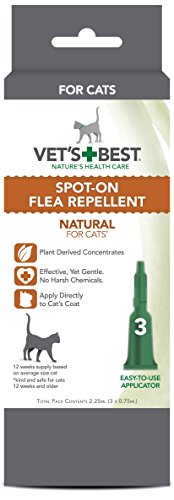








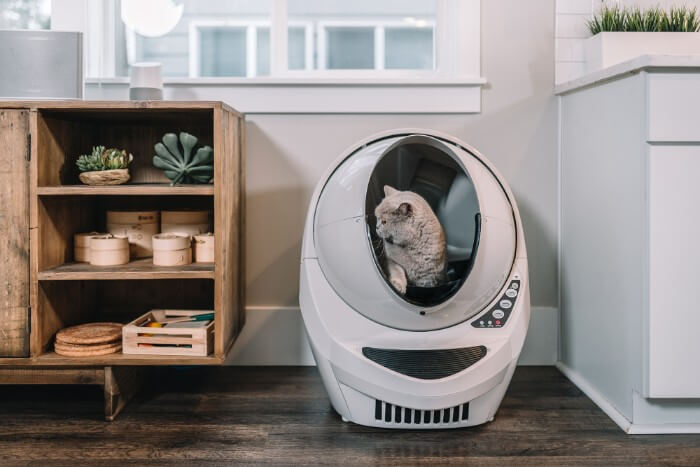


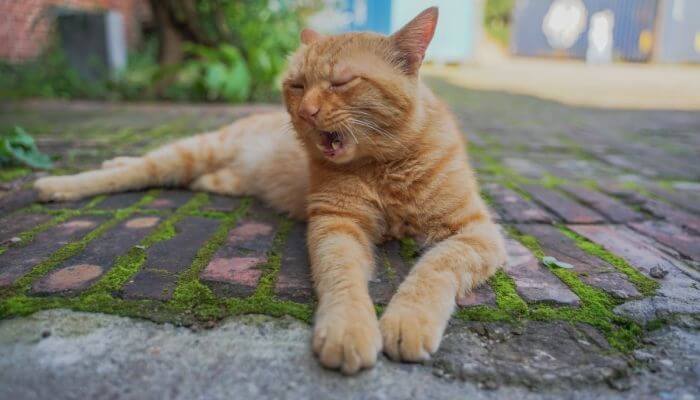
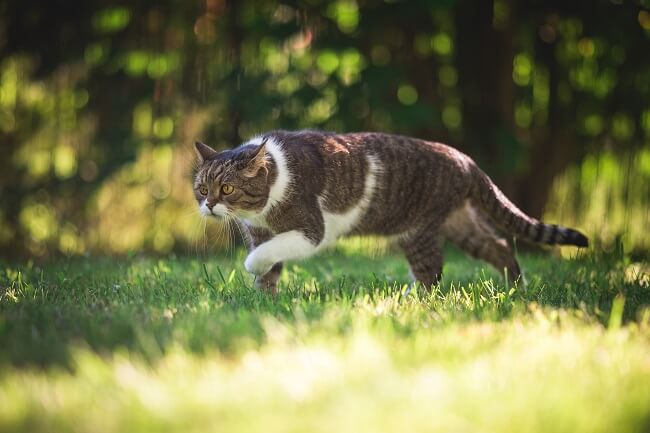
Leave a Comment